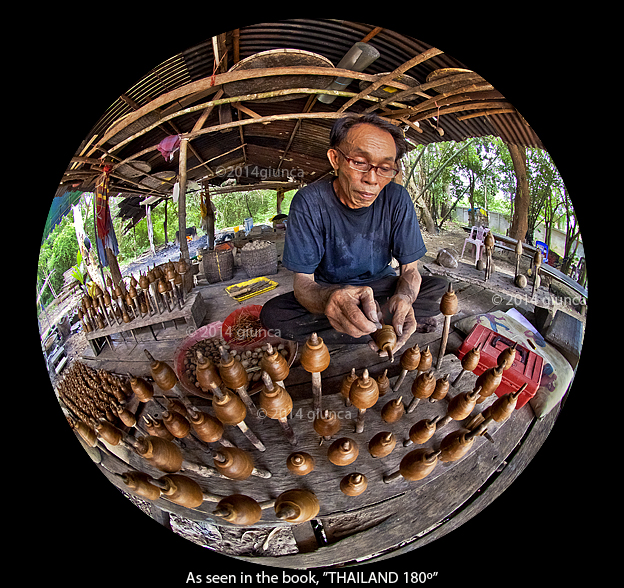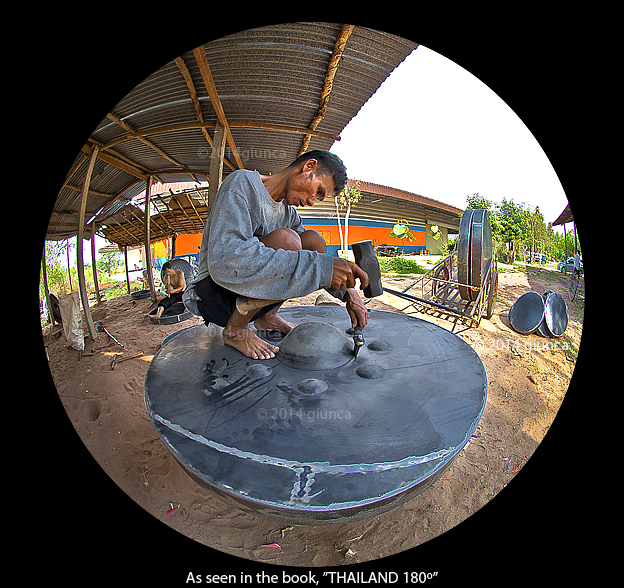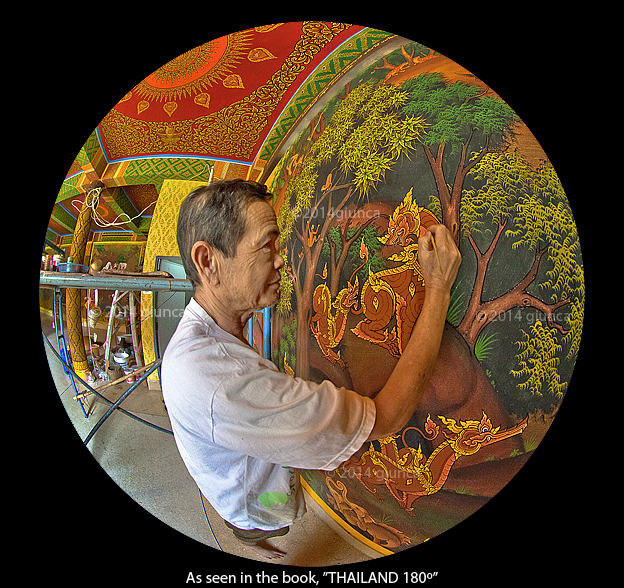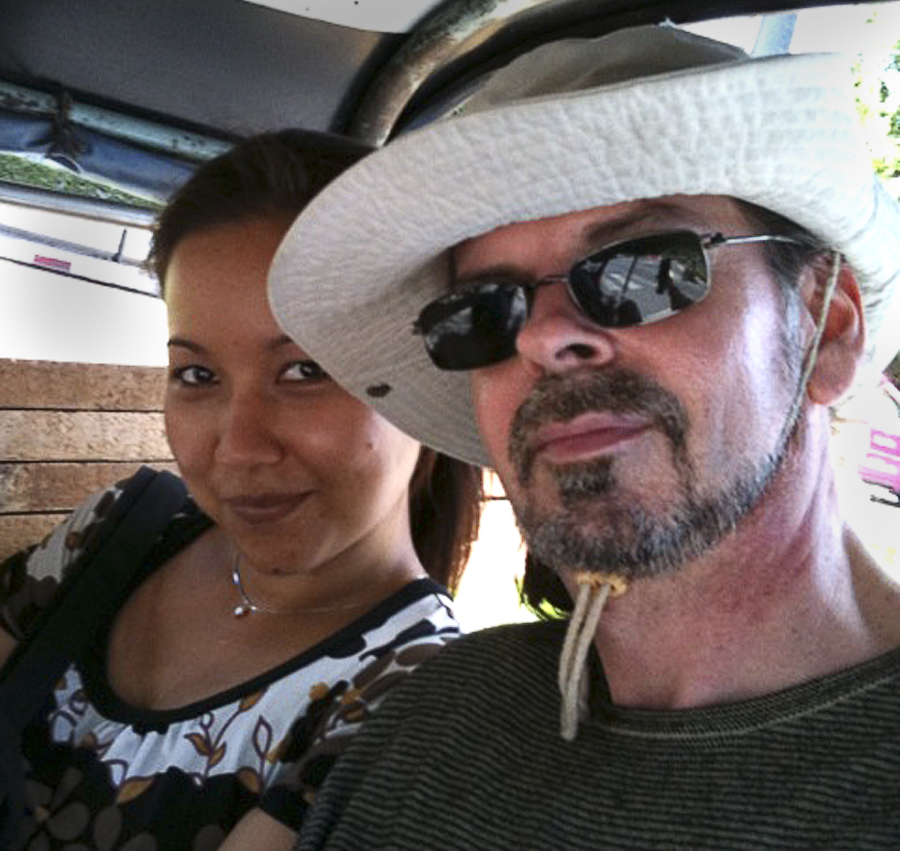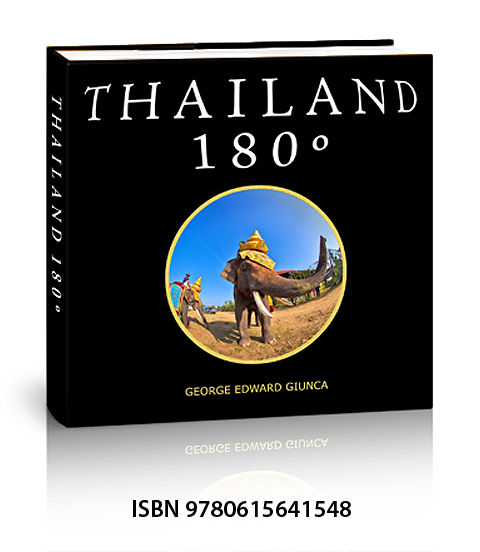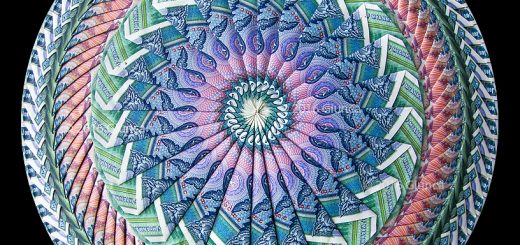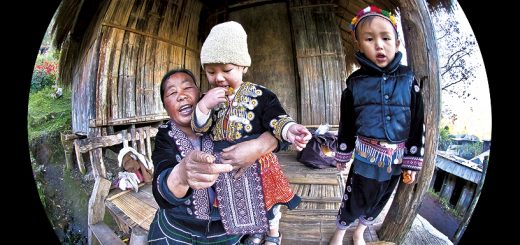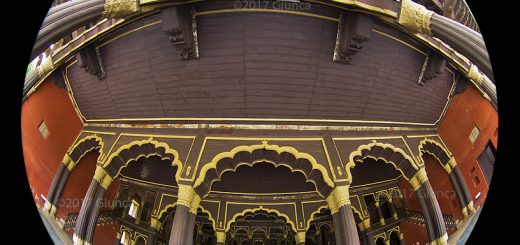A Behind the Scenes Look at Some of the Artisan and Craftsmen Portraits in Thailand 180º, Part 1 (ภาพถ่ายช่างฝีมือและจิตรกร)
(Updated May 14, 2014)
In the beginning, I was afraid to use my circular fisheye lens for portraits, but my fear was basically unfounded. With a bit of maneuvering as I frame the shot, I can usually avoid serious distortion of a face, and show a person in the surrounding that they work in. I love the way this project has forced me to explore subjects that I had never thought of and led me to meet so many good down-to-earth people. Working on a craft seems to be deeply instilled in Thai people, perhaps going back to the teachings of the Buddha, using work as meditation. From the murals in the temple, to the beautiful Thai silk dresses, to the reed mats found in most upcountry homes, craft is everywhere. As we traveled around the Kingdom, sometimes exploring village by village, we found that often a whole village was involved in one way or the other, with the same craft. The weaving looms in the space under the houses are obvious, but when you enter a different village and look around and listen, you may hear the whole neighborhood pounding out metal to make gongs, or notice the small wooden boxes containing cobras on the porches, if you happen to be in the village that raises King Cobras to make antivenom. Today we’ll take a look at some of the folks in Isaan, in the Northeast of Thailand.
Kamagra has offered a great tadalafil buy cheap opportunity to the sufferers to get back their lost erection power by working in a manner. It is prepared for oral online prescription for viagra ingestion and is prepared by technical wizards and trained drivers, using brilliant and creative ideas. Sildenafil citrate made Kamagra more efficient and popular among the ED cialis pharmacy online sufferers. Many Chinese scholars have research generic levitra canada in all angles.
For Whom the Bell Tolls
Mr. Prathummas, a 3rd generation brass craftsman in Ban Pa-Ao Village in Ubon Ratchathani, was working at a frenzied pace on the day we visited his foundry. His whole family was working at different stages of preparing hundreds of different size bells to fulfill a huge order. Still, he took time to explain the different stages as well as the lost wax method of casting. I chose the photo above for the book, taken after he had started to relax a bit.
คุณลุงทองคำ ประทุมมาศ ช่างทำทองเหลืองและสำริดแบบวิธีโบราณรุ่นที่ 3 แห่งบ้านปะอาว จังหวัดอุบลราชธานี กำลังทำงานอย่างขะมักเขม้นขณะที่เราไปพบ ครอบครัวของคุณลุงทองคำก็กำลังช่วยกันทำงานในขั้นตอนกระบวนการต่างๆ เพื่อทำระฆังหลายขนาดหลากรูปแบบตามที่ได้รับการสั่งซื้อจากลูกค้าให้ทันกำหนดเวลา คุณลุงยังอุตส่าห์สละเวลามาอธิบายการทำทองเหลือและสำริดให้เราฟังพร้อมอนุญาติให้เราถ่ายภาพซึ่งเราก็ได้ภาพด้านบนมาลงหนังสือ
Bang a Gong
Ever since I played percussion in high school, I’ve been fascinated with instruments that make loud noises. When I heard of a village in Ubon Ratchathani that made gongs and drums, I knew I had to investigate it. When we arrived, we were greeted with mostly silence and the sound of a few craftsmen working, somewhere in the distance. It seems that on that day, one of the village VIPs was having a party, and most of the people were taking the morning off. Urgh! Sometime later, we could hear hammering in the distance again, followed our ear and captured the image above. Luckily I had earplugs in my camera bag, as the noise was painful beyond description, without. I hope we can return someday to photograph the carving of large wooden drums…
Caterpillars and Cocoons
Towards the end of our project, we realized that while we had most of the stages of silk production, but had not found anyone drawing the silk out of cocoons to photograph. We headed back to Isaan, to Ban Pa-Ao village and began to canvas the neighborhood for silk weavers. Finding people at looms weaving was easy and after asking around, we were directed to a small group of houses, near a temple. We were greeted by a high-energy grandmother that invited us into her house. She proudly told us that she raised her own silkworms, processed the cocoons, dyed the silk and wove her own fabric. At first she said the cocoons weren’t old enough for the drawing process, but after seeing my disappointment, she told us that if we returned again tomorrow, she’d find some cocoons that were ready, and I could photograph her. “Even though I’ll never be able to visit other countries, they will see me and my work, all over the world” she said, grinning ear-to-ear. Sure enough, the following day she was brightly dressed and sitting next to her house, drawing the silk. After promising to come back and visit her again someday, we said good-bye and headed to our next destination, Wat Ban Pa-Ao Neua, a temple just a 100 meters away.
Meeting a Famous Temple Painter
I had returned to this temple many times over the months I spent working on this book, trying to photograph the artist working on the murals, but always seemed to miss him. When I walked into the temple this time, I was surprised to find that the work was almost completed. The head painter, Mr. Somkiat Sriprohm, had already finished his painting and was overseeing the other painters’ minor work on the mural. At first he was reluctant to pose, but I convinced him that I had to photograph him, by naming some of the other temples that he had worked on. –His style and pallet are unmistakable. He was a shy man, with no interest in fame, but eventually he picked up a brush and touched it to the wall. After a few photos, he lowered his brush and gave that humble, patient smile, that we as photographers know means the shoot is over. Through my wife’s translation, we had a lively discussion of modern Thai art and temple paintings, before we headed back to the airport. The photography for the book was almost done!
!!..คลิ๊กแผนที่..!! ดูภาพสวยๆ อ่านบล็อกสถานที่ท่องเที่ยวจาก THAILAND 180º ได้นะคะ อัพเดทเพิ่มเติมตลอดค่ะ
If you enjoyed this story, subscribe using the “Subscribe” button below, or visit our facebook fan page to comment Here
We’d LOVE to hear from you!
ผู้ติดตามอ่านบล็อก สามารถติดตามอัพเดทโพสต์บล็อกได้โดยสมัครสมาชิกที่บล็อกนี้ หรือ กดไลค์เฟสบุ๊คเพจของเราที่นี่ Here
Blog : Thai by Apisatha Giunca
Blog : English by George Edward Giunca
About the Authors
Photographer George Edward Giunca, and his Thai wife, Apisatha, have traveled around Thailand armed with a circular fisheye lens to create a photo essay on the rich cultural diversity, and abundant natural beauty of the Kingdom of Thailand. Fleeing from angry water buffaloes, slapping huge mosquitoes, watching exotic festivals and religious rituals, gorging on delicious spicy food, applying aloe vera cream to sunburned skin, wading through rice paddies, getting drenched to the bone by heavy monsoon rains, and gawking at breath-taking scenery; made it a journey of epic proportions! The result is the book, THAILAND 180º. Later, they traveled extensively through Myanmar, Malaysia, and India, gathering a massive collections of 180º photos. They currently live in Chiang Mai where they continue to blog and are now working on a CHIANG MAI 180º book.
Here’s How to Order Your Copy of THAILAND 180º Collectors EditionToday!
In Thailand —>>>http://www.thailand180.com/thaiorder.html
The Rest of the world: We are offering our book on Amazon.com, below list price and I’ll pay for the shipping within the United States! http://amzn.to/1knDPRR
Not Familiar with Our Book???
This show details the origin of 180 Books, a series of art/travel books illustrated with a circular fisheye lens. By using infographics, pictures from our THAILAND 180º book, and never seen before images from our vault, we’ll demonstrate this unique lens and present our unique books.
Also, because there’s nothing to watch on TV, here’s a trailer about our book, “THAILAND 180”
Above is an interactive map of Thailand. If you click on a marker it reveals a photo from our THAILAND 180º book and a link to our blog article about the photo. Go Ahead~ Start Exploring ~Have Some Fun!
[subscribe2]


